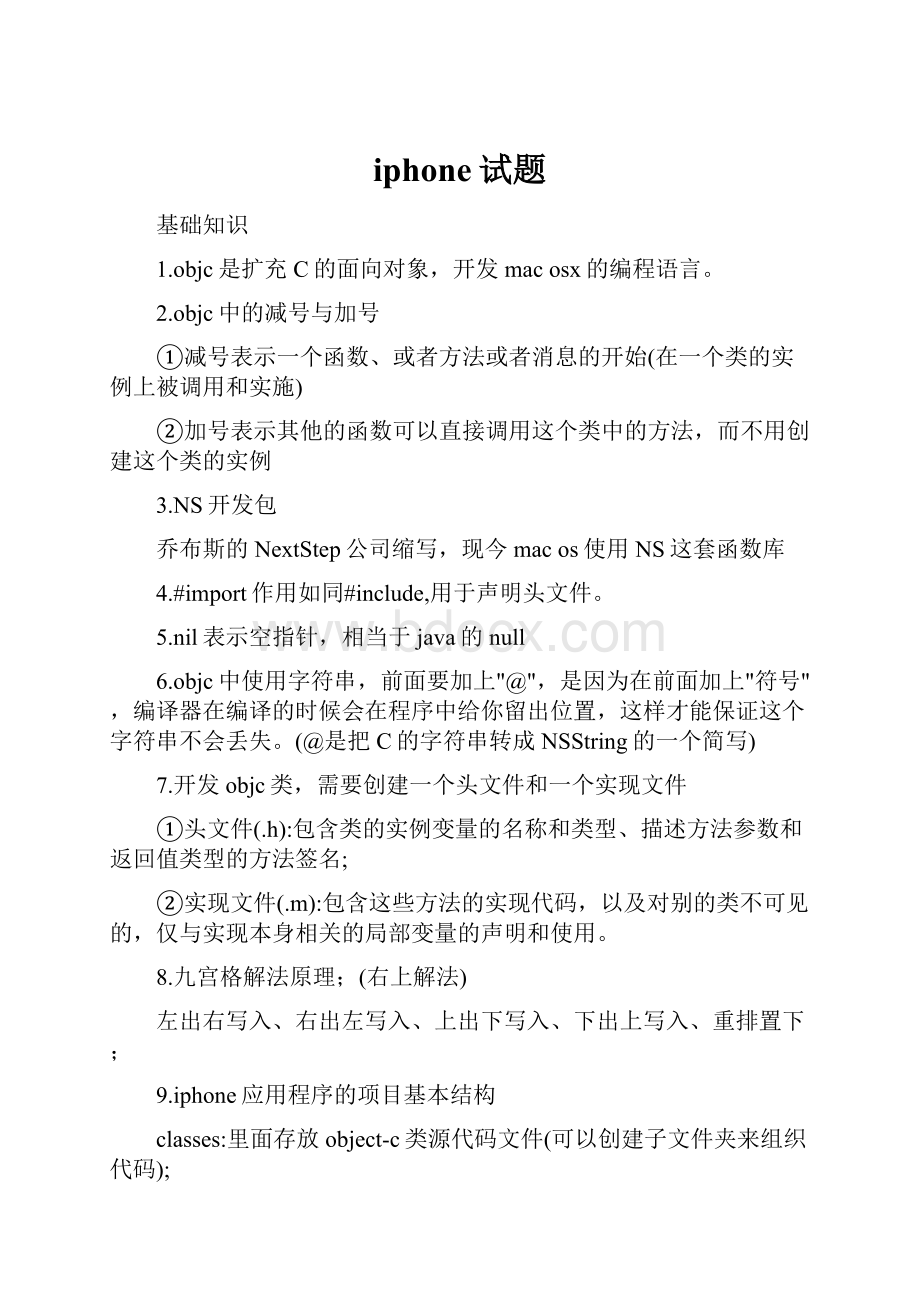iphone试题.docx
《iphone试题.docx》由会员分享,可在线阅读,更多相关《iphone试题.docx(16页珍藏版)》请在冰豆网上搜索。

iphone试题
基础知识
1.objc是扩充C的面向对象,开发macosx的编程语言。
2.objc中的减号与加号
①减号表示一个函数、或者方法或者消息的开始(在一个类的实例上被调用和实施)
②加号表示其他的函数可以直接调用这个类中的方法,而不用创建这个类的实例
3.NS开发包
乔布斯的NextStep公司缩写,现今macos使用NS这套函数库
4.#import作用如同#include,用于声明头文件。
5.nil表示空指针,相当于java的null
6.objc中使用字符串,前面要加上"@",是因为在前面加上"符号",编译器在编译的时候会在程序中给你留出位置,这样才能保证这个字符串不会丢失。
(@是把C的字符串转成NSString的一个简写)
7.开发objc类,需要创建一个头文件和一个实现文件
①头文件(.h):
包含类的实例变量的名称和类型、描述方法参数和返回值类型的方法签名;
②实现文件(.m):
包含这些方法的实现代码,以及对别的类不可见的,仅与实现本身相关的局部变量的声明和使用。
8.九宫格解法原理;(右上解法)
左出右写入、右出左写入、上出下写入、下出上写入、重排置下;
9.iphone应用程序的项目基本结构
classes:
里面存放object-c类源代码文件(可以创建子文件夹来组织代码);
othersources:
存放除objective-c类之外的源代码文件;
resources:
包含应用程序中的非代码文件(因为应用程序只能在自己的沙盒中运行,不然找不到);
Frameworks:
特殊的库,可以存放库、框架、图像、声音等资源;
Products:
包含项目在编译时生成的应用程序(xxx.app);
10.Info.plist文件里的bundleidentifier(束标识符)
它是应用程序的唯一标识符,要始终配置,命名格式为:
顶级Internet域+.+公司名称+.+应用名称;
11.一个在代码里对nib中对象(UILabel、UITextField等)的引用被称为一个插座变量(outlet),用关键字IBOutlet标明(在头文件里);能够被nib中对象调用的方法称为动作(action),用关键字IBAction标明(在实现文件里)。
12.在实现某个动作或是对象后要对这个动作或是对象后要使用release释放内存。
13.IBOutlet
输出口使用关键字IBOutlet来声明实例变量,并通过这个实例变量来引用nib中的对象;
14.-(IBAction)doSomething:
(id)sender
控制某个对象执行某项动作通过关键字IBAction来声明,通过IBAction告诉interfaceBuilder,此方法是一个操作,且可以被某个控件触发;通常这个操作接受一个参数,该参数被定义为id,名称被指定为sender.(当需要传参数的时候就通过sender来传递,当不需要传参数的时候sender可以不写的);
15.@property(retain,nonatomic)UILabletextArea;
retain是通知编译器向分配给此属性的对象发送一个保留(retain)消息,确保属性的实例变量在被使用过程中不会被从内存中删除;
nonatomic是创建一个互斥访问,避免读和写不同步(非原子性访问);
通过这个属性声明访问来提高执行的效率;(原子性好比如我们去银行存钱,存进去的时候银行账户就会同时增加相应的数额,有一面失败就都回到原来的状态);
16.内存管理理解
①:
程序A里有一段内存被成功申请完成之后,内存计数器就从0变为1
(这个过程是alloc);
②:
然后程序B里也要使用这个内存,那么内存计数器从1变为2
(这个过程是retain);
③:
紧接着程序A不需要这个内存了,那么程序A就把这个内存计数器减1
(这个过程是release);
④:
当系统发现这个内存计数器变为0,那么就调用内存回收程序把这段内存回收(这个过程是dealloc);
17.objc使用消息机制来调用方法,消息就是一个类或者对象可以执行的动作
消息表达式:
[对象或者类名字方法名字:
参数序列];
对象或者类名字:
接收器,是消息的接收者;
方法名字:
参数序列:
要发送的消息(要执行的动作);
代码实现
1.实现图像的移动
NSTimer*timerArrow;
-(IBAction)shoot
{
timerArrow=[NSTimerscheduledTimerWithTimeInterval:
(0.03)target:
selfselector:
@selector(onTimerArrow)userInfo:
nilrepeats:
YES];
}
-(void)onTimerArrow{
NSLog(@"gogogo");
//transform后的参数为图像移动的x,y的距离
arrowView.transform=CGAffineTransformTranslate(arrowView.transform,0,-3.0);
}
2.实现图像的旋转可以有两种实现方式(UIImageView*imageView)
①.使用CGAffineTransformMakeRotation类的类方法CGAffineTransformRotate方法。
imageView.transform=CGAffineTransformRotate(imageView.transform,-0.02);
②.使用CGAffineTransformMakeRotation类的类方法CGAffineTransformMakeRotate方法。
floatangle=0;
angle+=-0.02;
imageView.transform=CGAffineTransformMakeRotation(angle);
3.时间条的读取(UIProgressView*pg)
intprogress=0;
progress++;
//时间条读取的速度,取决于时间的多少(此处为30秒的倒数[1/30])
[pgsetProgress:
progress*0.033];
4.屏幕轻击、触摸事件
①.点击次数
//NSUInteger为无符号的整形
NSUIntegernumTaps=[[touchesanyObject]tapCount];
NSString*tapsMessage=[[NSStringalloc]initWithFormat:
@"%dtapsdetected",numTaps];
②.触摸开始
-(void)touchesBegan:
(NSSet*)toucheswithEvent:
(UIEvent*)event
{
}
③.触摸移动
-(void)touchesMoved:
(NSSet*)toucheswithEvent:
(UIEvent*)event
{
}
④.触摸取消,通常为内存不够用的时候调用
-(void)touchesCancelled:
(NSSet*)toucheswithEvent:
(UIEvent*)event
{
}
⑤.触摸结束
-(void)touchesEnded:
(NSSet*)toucheswithEvent:
(UIEvent*)event
{
}
⑥.轻扫屏幕
.h
UILabel*label;
CGPointmarker;
.m
-(void)touchesBegan:
(NSSet*)toucheswithEvent:
(UIEvent*)event{
UITouch*touch=[touchesanyObject];
marker=[touchlocationInView:
self.view];
}
-(void)touchesMoved:
(NSSet*)toucheswithEvent:
(UIEvent*)event{
UITouch*touch=[touchesanyObject];
CGPointmoved=[touchlocationInView:
self.view];
CGFloatdeltaX=fabsf(marker.x-moved.x);
CGFloatdeltaY=fabsf(marker.y-moved.y);
if(deltaX>=25&&deltaY<=5)
{
label.text=@"yesyesyes";
}
elseif(deltaX<=5&&deltaY>=25)
{
label.text=@"nononono";
}
}
5.循环执行一个方法可以有两种实现方法
①.使用NSTimer类的相关方法。
NSTimer*timer;
intcount=0;
-(void)do
{
NSLog(@"Testtimer");
count++;
//10秒之后timer停止
if(count>=10)
{
[timerinvalidate];
}
}
-(void)viewDidLoad{
timer=[NSTimerscheduledTimerWithTimeInterval:
1target:
selfselector:
@selector(do)userInfo:
nilrepeats:
YES];
}
②.使用NSObject类的performSelector:
withObject:
afterDelay方法。
-(void)do
{
NSLog(@"Testtimer");
[selfperformSelector:
@selector(do)withObject:
nilafterDelay:
1];
}
-(void)viewDidLoad{
[selfdo];
}
6.根据选择的按钮,将按钮的title传给标签并显示出来(UILable*status)
NSString*title=[sendertitleForState:
UIControlStateNormal];
NSString*newText=[[NSStringalloc]initWithFormate:
#"youpressthe%@",title];
status.text=newText;
[newTextrelease];
7.点击done关闭键盘(UITextField*nameField)
-(IBAction)nameFieldDoneEditing:
(id)sender;
-(IBAction)nameFieldDoneEditing:
(id)sender
{
[senderresignFirstResponder];
}
点击屏幕关闭键盘
-(IBAction)backgroundClick:
(id)sender;
-(IBAction)backgroundClick:
(id)sender
{
[nameFieldresignFirstResponder];
}
8.通过UISegmentedControl控制UIView(UIView*switch)显示或是隐藏的状态;
-(IBAction)toggleShowHide:
(id)sender
{
UISegmentedControl*segmentedControl=(UISegmentedControl*)sender;
//查询uisegmentcontrol的值
NSIntegersegment=segmentedControl.selectedSegmentIndex;
if(segment==0)
[switchViewsetHidden:
NO];
else
[switchViewsetHidden:
YES];
}
9.UISwitch(UISwitch*soundSwitch)开关的控制
-(IBAction)switchChanged:
(id)sender
{
UISwitch*whichSwitch=(UISwitch*)sender;
BOOLsetting=whichSwitch.isOn;
[SoundSwitchsetOn:
settinganimated:
YES];
}
10.操作表
使用操作表必须符合协议(在.h头文件里的UIViewController后添加);
同时操作表是模式化的(模式化就是程序显示操作表时,程序的其他任何部分都是不可操作的,
必须在操作表上作出选择,才可以执行其他的操作);
-(IBAction)doSomething:
(id)sender
{
UIActionSheet*actionSheet=[[UIActionSheetalloc]initWithTitle:
@"ready?
"
delegate:
self
cancelButtonTitle:
"No"
destructiveButtonTitle:
"Yes"
otherButtonTitle:
@"Woo",@"Cool",nil];
[actionSheetshowInview:
self.view];
[actionSheetrelease];
}
里面的delegate:
self通过将self做为委托参数传递给actionsheet:
didDisMissWithButtonIndex:
actionSheet的方法,当按钮被按下的时候,委托的actionsheet:
didDisMissWithButtonIndex:
actionSheet方法将会被调用;
通过UIActionSheetDelegate的actionSheet:
didDismisswithButtonIndex方法的buttonIndex来指向
操作的索引;
①如果想通过操作表的destructiveButton按钮来执行某项操作;
if(buttonIndex==[actionSheetdestructiveButtonIndex])
{
doSomething;//你要做的操作,显示警报或是别的动作
}
②通过操作表的Woo按钮来执行某项操作;
if(buttonIndex==[actionSheetfirstOtherButtonIndex])
{
doSomething;
}
③通过操作表的cool按钮来执行某项操作;
if(buttonIndex-1==[actionSheetfirstOtherButtonIndex])
{
doSomething;
}
11.警报
NSString*msg=nil;
msg=@"Pleaseclickonthegobuttontogetthecoupons.";
UIAlertView*alert=[[UIAlertViewalloc]
initWithTitle:
@"Congratulations"
message:
msg
delegate:
self
cancelButtonTitle:
@"Back"
otherButtonTitles:
@"Go",@"Got",nil];
[alertshow];
[alertrelease];
[msgrelease];
对警报里的按钮做相对应的点击处理(以点击Got按钮显示店铺的宣传网站)
-(void)alertView:
(UIAlertView*)alertViewclickedButtonAtIndex:
(NSInteger)buttonIndex{
switch(buttonIndex){
case0:
//Cancelbutton
break;
case1:
//Go!
button
break;
default:
//Got!
button
[[UIApplicationsharedApplication]openURL:
[NSURLURLWithString:
@"
}
}
12.自动旋转
UIInterfaceOrientationPortrait//直立
UIInterfaceOrientationPortraitUpsideDown//倒立
UIInterfaceOrientationLandscapeLeft//左翻转
UIInterfaceOrientationLandscapeRight//右翻转
如果想设定应用程序是否支持自动翻转,通过interfaceOrientation来设定;(设定后也要手动的调整对应的页面视图的属性)
-(BOOL)shouldAutorotateToInterfaceOrientation:
(UIInterfaceOrientation)interfaceOrientation
{
return(interfaceOrientation==视图朝向);
}
13.切换视图
①.首先添加控制视图的viewController类(负责程序的视图跳转此处定义为switchViewController);
②.添加好程序需要的视图控制类和相对应的xib文件,并在视图xib文件的类特性编辑器里设置好它的基类和视图
输出口;
③.在应用程序委托里写好调用视图跳转的函数
.h
+(Pizza_RockAppDelegate*)App;
.m
+(Pizza_RockAppDelegate*)App{
return(Pizza_RockAppDelegate*)[[UIApplicationsharedApplication]delegate];
}
④.在控制视图的viewController类里,写跳转视图的方法;
-(void)showRockView
{
if(self.pizza_RockViewController==nil)
{
self.pizza_RockViewController=[[Pizza_RockViewControlleralloc]initWithNibName:
@"Pizza_RockViewController"bundle:
nil];
}
[selfremoveAllView];
[self.viewinsertSubView:
self.pizza_RockViewController.viewatIndex:
0];
}
-(void)removeAllView
{
for(NSIntegeri=0;i<[self.view.subViewscount];i++)
{
[[self.view.subviewsobjectAtIndex:
i]removeFromSuperview];
}
}
⑤.在视图控制类里调用应用程序委托里写好的函数来完成视图的跳转
-(IBAction)buttonClick:
(id)sender
{
[[Pizza_RockAppDelegateApp].switchViewControllershowRockView];//showRockView为在控制视图跳转的类里定义好的方法
[labelremoveFromSuperview];
}
14.建立工具栏(TabBarController)
①.创建控制视图的viewController类以及控制视图所对应的视图xib文件(工具栏有几个标签控制器,则创建几个控制视图类文件);
②.设置视图nib对应的viewController类,并设置好File'sOwner的输出口为对应的view;
③.在应用程序委托里创建UITabBarController的实例;
④.在MainWindow.xib里,添加一个TabBarController,并在属性检查器里添加工具栏所需要的标签控制器,并设置好标签控制器
对应的标题名称、NIBNAME、图标;
15.表视图
表视图从遵循UITableViewDelegate协议的对象中获取配置数据;
从遵循UITableViewDataSource协议的对象获得行数据;
①.查看指定分区并返回表分区中的行数;(NSArray*listData)
-(NSInteger)tableView:
(UITableView*)tableViewnumberOfRowsInSection:
(NSInteger)section
{
return[self.listDatacount];
}
②.根据声明的字符串键值来绘制表视图中的行
-(UITableViewCell*)tableView:
(UITableView*)tableViewcellForRowAtIndexPath:
(NSIndexPath*)indexPath
{
//声明表单元里的键值(标识符)
staticNSString*SimpleTableIdentifier=@"SimpleTableIdentifier";
//根据这个声明的键值返回可重用的表视图标识符
UITableViewCell*cell=[tableViewdequeueReusableCellWithIdentifier:
SimpleTableIdentifier];
if(cell==nil)
{
cell=[[[UITableViewCellalloc]initWithFrame:
CGRectZeroreuseIdentifier:
SimpleTableIdentifier]autorelease];
}
NSUIntegerrow=[indexPathrow];
cell.text=[listDataobjectAtIndex:
row];
returncell;
}
③.为指定的行添加图像
//0为要添加图像的行数的下标
if([indexPathrow]==0)
{
UIImage*image=[UIImageimageNamed:
@"beef.png"];
cell.image=image;
}
④.设置表视图的缩进级别(树状的表视图以后弄清楚)
-(NSInteger)tableView:
(UITableView*)tableViewindentationLev